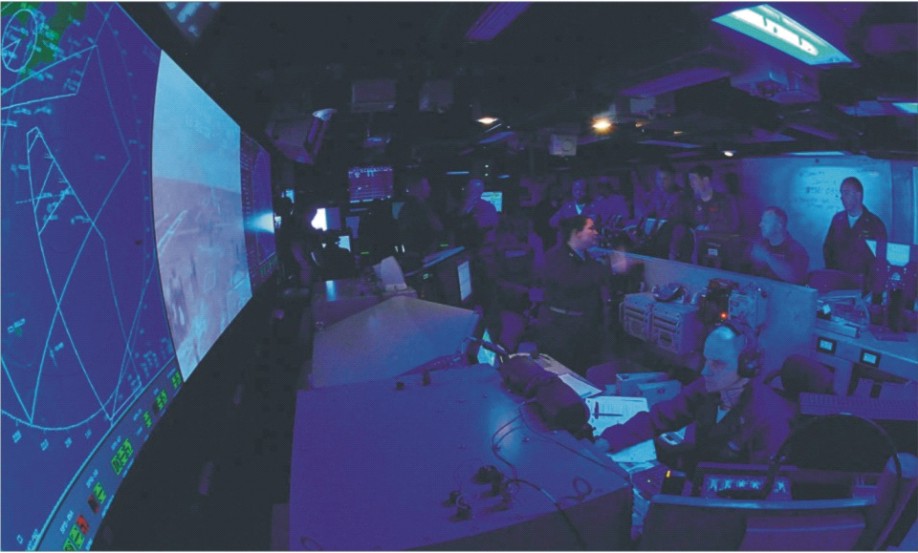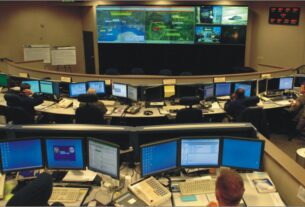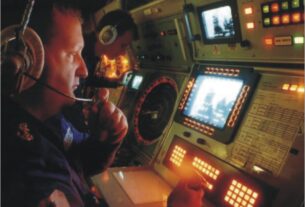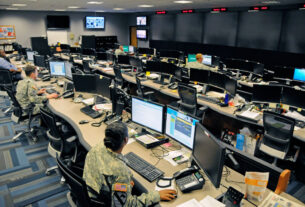Wars are no longer fought in traditional battle spaces. Combat zones have now become digitized and hence require flawless, uninterrupted and secure communication, as the modern day battle will be fought at the speed of thought.
Thus, in this day and age, no military force can afford to bypass the Network Centric Warfare (NCW) concept.
NCW operations encompass the linkage of people, systems, and platforms to form a self-synchronised, networked force that creates shared battle space awareness, provides information superiority and speed of command.
An integrated networked force allows military personnel to come together and communicate in ways previously unknown. NCW reduces the time it takes to convert military commander’s intent into action. This increases combat efficiency. It thus redefines the character of warfare and strengthens the foundation for a precise digitized approach to operations.
The Indian Navy had recognised this trend early and the challenge in the past decade has been to integrate NCW concept, into its methods of war-fighting. As a start point, a robust communication and information organisational tree at the Headquarters level is mandatory for network-centric operations.
At the turn of this century, the Navy had evaluated the implications of NCW initiatives to establish requirements of manpower and training for future networked-operations, both for afloat and shore organizations.
Thereafter, the Navy incorporated necessary organizational structures to support NCW initiatives at the level of Naval Headquarters (NHQ), as also at the Command and Fleet levels, and induct NCW wherewithal relevant to IN (Indian Navy) operational concepts.
More than five year ago, the Directorate of Network Centric Operations (DNCO) was established at NHQ, New Delhi. With the creation of a Directorate of NCO and the formulation of a core-team for NCW, initial steps had been taken to build the NCW pyramid, and formulate a long-term plan for Network Centric Warfare.
In the subsequent years, demystification of NCW terminology gradually took place and efforts were made to formulate a common operating vocabulary, as also to induct systems that met the stringent demands of maritime information-sharing.
At present, efforts are underway to standardize the procurement of hardware, in order to overcome challenges of a wide variety of AIO (Action Information Organization) systems on afloat units.
Further, against the backdrop of increasing role of satellites in modern warfare, the Indian Navy has created in 2012 a new post of Assistant Chief of Naval Staff (Communications, Space and Network Centric Operations) at NHQ, New Delhi. The creation of the new post is a step in the process to migrate from a “platform-centric Navy” to a “network-enabled Navy”.
Operational philosophy
The communication channels within the Navy, whether ship to ship, ship to shore or shore to ship, from voice circuits to data communications have progressively shifted in the last decade .
Further, the comfort-levels with home-grown systems, whether developed in-house by the motivated team at DNCO and its nodes at Command HQ’s or in collaboration with DRDO/BEL, has risen substantially, as has the Navy’s manifest capability to overcome technical challenges posed by hardware and software.
NCW derives its value from the strong networking of a well connected but geographically dispersed force, and improves the effectiveness of military operations.
This falls into place with the Indian Navy’s quest to operate at distances away from the Indian coast for longer periods. Concepts like expeditionary warfare, satellite communications and ships with long ‘sea legs’, have been engendered, as a part of this quest.
The future battle space will be fast-paced and complex and NCW provides the Indian Navy important tools to deal with this complexity.
However, while increased connectivity would enable the integration to take place, there would be a simultaneous requirement to develop the doctrine to better exploit NCW concept.
It is in this background that Navy’s NCW doctrine is under constant evolution, which seeks to seamlessly integrate all combat platforms and terrestrial nodes through cutting edge communications and space systems.
The induction of assets that enhance surveillance, identification and exchange-of-information will remain vital to NCW initiative.
Induction of UAV’s (Unmanned Aerial Vehicles) in the Indian Navy ties in with this philosophy, since a UAV’s endurance and surveillance capabilities are crucial for a force like the Indian Navy.
Further, the availability of a dedicated geo-stationary satellite for the Navy in the very near future will be a great advancement towards the NCW concept. This satellite, expected to be launched by ISRO in early 2013, is known as the GSAT-7 Communication satellite, also identified as INSAT-4F.
The satellite was originally planned to be launched in the year 2010, however, owing to delays arising out of the GSLV programme, the programme is running behind schedule.
With a thousand nautical mile footprint over the Indian Ocean Region, the satellite will be able to network all its warships, submarines and aircraft with operational centres ashore through high-speed data-links.
The entire fleet and command centres on land would be able to share the information of a hostile action, in real-time, to ensure swift reaction. Communications will be over secure satellite channels, unlike the present high-frequency radio waves which can be intercepted. The future over-the-sea satellites will also enable imaging and mapping.
As the decades go by and the Indian Navy grows into a more formidable and technological intensive Navy, robust military space programs are vital to augment network centric operations, by providing capabilities, inter alia, missile early-warning, delivery of precision-guided munitions through satellite signals and jamming enemy networks.
Cooperative Engagement Capability (CEC)
As a subset of Network Centric Warfare, the concept of CEC was developed to improve the ability to conduct Air Defence (AD). In AD, instant reaction is a key factor since the time available to detect, track, classify, and engage targets is limited.
This paucity of time mandates networking of sensors and weapons, for improved AD cover, as information superiority is directly translated into combat superiority.
The AD concept has proliferated to the maritime domain as well. Take the case of a fleet of Indian Navy destroyers/frigates operating in waters distant from the Indian coast, in an AD role.
In case of platform centric warfare, weapon engagement is possible only when a destroyer or a frigate is able to acquire (track and lock on) the adversary fighter aircraft/UAV, which has been launched from shore.
However, NCW allows for fastest dissemination of engagement level data from the sensor grid to the shooter grid, where the system best suited, on any destroyer or frigate, engages the target.
NCW thus enables sensors and weapons to operate in close coordination, and ensures that the operational sequence from target acquisition to engagement, can be accomplished in the quickest possible way, much faster than what was possible in platform-centric warfare.
For the Indian Navy, which now endeavours to operate increasingly in far-flung waters, this is a boon. Thus, CEC can be defined as the capability of the network enabled system to use sensors fitted on multiple platforms for target updates, and thereafter undertake engagement with the most appropriately suited weapon, on any of the platform.
Networking of weapons and sensors thus increases the kill factor and reduces risk profiles. CEC will therefore remain central to Navy’s NCW endeavours.
Network-centric warfare is the product of the convergence of computers and communication. A concept like NCW never stops evolving, and it is never fully mature. It is a continuous process and transforms in complexity and efficiency as the technology leapfrogs.
There is a broad understanding within the Indian Navy that through this process of technology transformation, NCW will be one of the key enablers of operational effectiveness, and not be an end in itself. Thus, NCW initiatives will be benchmarked in their utility towards improving the war fighting potential.
Further, NCW is not only about networks and networking, it is about operations and people. Functionally, the personnel who apply their skills and experience in converting data into action are the most important pillar of NCW. Training of personnel at all echelons of the Navy, to deal with the increasing demand on handling of information, will be critical.
In conclusion, an increasing focus and reliance on NCW by the Navy, in the era beyond 2012, is inevitable.
(The author is former Indian Navy officer)





